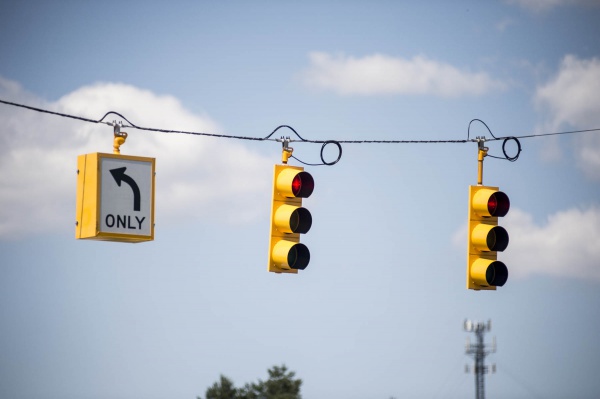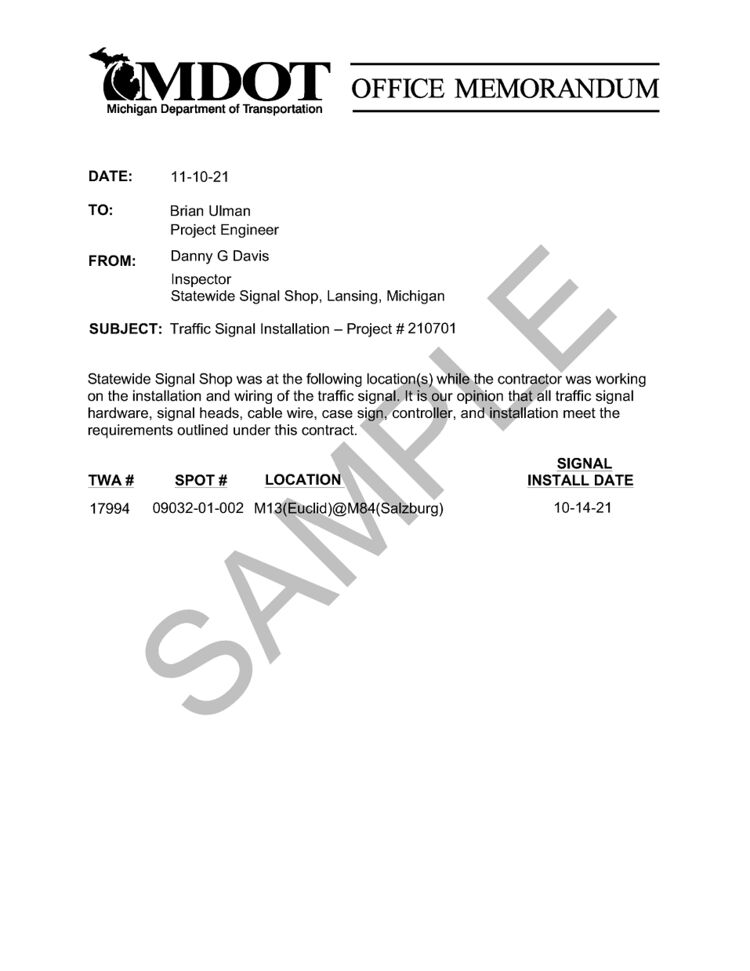Difference between revisions of "820 - Traffic Signals"
(Added Section 4.1 Acceptance of Traffic Signal Work) |
(→MEASUREMENT AND PAYMENT: update sentence for links applicable pay items) |
||
| Line 71: | Line 71: | ||
===[[#Acceptance of Traffic Signal Work|Acceptance of Traffice Signal Work]]=== | ===[[#Acceptance of Traffic Signal Work|Acceptance of Traffice Signal Work]]=== | ||
| − | An inspection work authorization (IWA) will be issued by the signals unit for all projects that contain traffic signal pay items. If the project engineer has not received a copy of the IWA by the time of the preconstruction meeting, please contact the signals unit to expedite the IWA. The agency listed first on the IWA will be responsible to determine suitability and compliance with specifications for the signal items. This agency must provide the project engineer with a memo or other documented acceptance of the signal work items prior to proceeding to the Final Inspection of the project by the construction/project engineer. In addition, it is recommended that the project engineer only pay 80 percent of pay item costs for devices installed, but not yet approved by the maintaining agency. | + | An inspection work authorization (IWA) will be issued by the signals unit for all projects that contain traffic signal pay items. If the project engineer has not received a copy of the IWA by the time of the preconstruction meeting, please contact the signals unit to expedite the IWA. The agency listed first on the IWA will be responsible to determine suitability and compliance with specifications for the signal items. This agency must provide the project engineer with a memo or other documented acceptance of the signal work items prior to proceeding to the Final Inspection of the project by the construction/project engineer. In addition, it is recommended that the project engineer only pay 80 percent of pay item costs for devices installed, but not yet approved by the maintaining agency. Here are the [https://mdotwiki.state.mi.us/images_construction/a/a5/820_Applicable_Pay_Items_List.pdf applicable pay items]. Once all signal devices are determined to be working as intended and the acceptance memo is received, full payment should be made. A sample memorandum is provided below, and a blank form is available by clicking on the sample image: |
[[File:CL 09032-01-002 - sample.jpg|thumb|center|750px|link=//{{SERVERNAME}}/images_construction/7/73/CL_09032-01-002_-_blank.pdf]] | [[File:CL 09032-01-002 - sample.jpg|thumb|center|750px|link=//{{SERVERNAME}}/images_construction/7/73/CL_09032-01-002_-_blank.pdf]] | ||
Revision as of 13:38, 11 October 2022
GENERAL
-Reserved-
MATERIALS
Traffic Signal Installation, Steel Strain Pole Band Clamps
Steel band clamps are used for traffic signal span wire installation on steel strain poles. Clamps must meet the material requirements in Special Detail SIG-010-A “Span Wire T.S. on Steel and Wood Poles”, Detail B, Pole Band Clamps on Steel Pole”, which specifies ASTM A36 steel bands using ASTM A325 galvanized steel bolts.
Pole band clamps must be stamped with identification that is traceable back to the manufacturer, which can be used to determine the month and year of clamp manufacture. The stamping method must be a low stress stamping method. The stamp cannot be located near the bolted flange, must be located near the center of the backside clamp from traffic on the outside face, and be visible after galvanizing. Any questions regarding clamp identification can be directed to the Traffic Signals Unit at 517-322-3360.
The minimum inside bend radius for cold formed members must be at least 1.5 times the material thickness (or 3/8 inches).
CONSTRUCTION
Notification of Traffic Signal Work
It is the contractor's responsibility to notify MDOT’s Statewide Signal Shop prior to beginning any signal work. Traffic signal projects include a note in the project plans that state the following, "Contact MDOT (and any other maintaining agency) seven (7) working days prior to start of construction and seven (7) working days prior to signal activation.” Appropriate contact information is indicated in the plan notes. The seven day time frame will allow for coordination between the contractor and the Statewide Signal Shop for installation and inspection of traffic signal work. It is recommended that these notification requirements be discussed at the pre-construction meeting.
The Statewide Signal Inspector must be on-site to help to ensure that unsafe conditions with the traffic signals are not utilized or incorporated into the project work and to protect the safety of the public. Any work done incorrectly will need to be corrected at the contractor's expense.
If an inspector from MDOT’s Statewide Signal Shop or appropriate maintaining agency is not on site when a contractor is performing signal work, the project representative (MDOT/consultant engineer or inspector) should stop the signal work until verification of prior notice to MDOT has been confirmed. Construction staff should call the Statewide Signal Shop at 517-322-3360 to verify whether inspection notification requirements have been met. If prior notification was not provided by the contractor, form 1165, Notice of Non-Compliance with Contract Requirements is to be issued until the contractor properly notifies the Statewide Signal Shop and necessary inspection arrangements have been made.
To ensure proper coverage and discussion Jim Kwapiszewski, should be invited to preconstruction meetings for projects that involve any traffic signal work.
Traffic Signal Pole Locations
The American with Disabilities Act (ADA) requires pedestrian pushbuttons be placed strategically to provide accessibility for any person with disabilities. There are mandatory distances for placement of pushbuttons in conjunction with crosswalks. Also, there are traffic signal timing implications for placement of the pushbuttons. Traffic signal installations are designed to specifically accommodate those requirements. Traffic signal pushbuttons can be placed on isolated pedestals or in combination with traffic signal support poles. When a designed pole location is relocated without knowledge or approval of the Traffic Signals Unit, it could result in a violation of the ADA requirements and open the department to litigation. Do not approve changes to traffic signal operations without knowledge or approval of the Traffic Signals Unit. Changes of this nature can have implications to ADA requirements.
When it becomes apparent that a designed signal pole location is not feasible, or a request for a change in operation has come from outside the Traffic Signals Unit, construction staff must contact the Traffic Signals Unit in Lansing. The Traffic Signals Unit will assist in determining where to move the pole, along with any changes made to the signal operation, while maintaining compliance with ADA requirements.
Traffic Actuation of Temporary Traffic Signals
When using trailer mounted temporary traffic signals on projects, review each site to determine if the temporary traffic signals should be required to be retrofit for traffic actuation.
Temporary traffic signals should be retrofit for actualization when any one or more of the following conditions exist on the project site:
- Traffic volumes that are low enough to create time periods when a vehicle would be held on a normally timed red signal where no opposing traffic is present.
- Traffic volumes that are directional, where directional traffic may be stopped on a red indication before the entire queue can clear the signal.
Construction staff should work with region/TSC traffic and safety staff to determine if the temporary traffic signal location should be considered for actuation.
If it is determined the temporary traffic signal meets the requirements to be retrofit, advise the contractor of the required additions to the temporary traffic signal, and pay for the retrofit as a contract extra work item with a negotiated extra cost.
MEASUREMENT AND PAYMENT
Acceptance of Traffice Signal Work
An inspection work authorization (IWA) will be issued by the signals unit for all projects that contain traffic signal pay items. If the project engineer has not received a copy of the IWA by the time of the preconstruction meeting, please contact the signals unit to expedite the IWA. The agency listed first on the IWA will be responsible to determine suitability and compliance with specifications for the signal items. This agency must provide the project engineer with a memo or other documented acceptance of the signal work items prior to proceeding to the Final Inspection of the project by the construction/project engineer. In addition, it is recommended that the project engineer only pay 80 percent of pay item costs for devices installed, but not yet approved by the maintaining agency. Here are the applicable pay items. Once all signal devices are determined to be working as intended and the acceptance memo is received, full payment should be made. A sample memorandum is provided below, and a blank form is available by clicking on the sample image:

